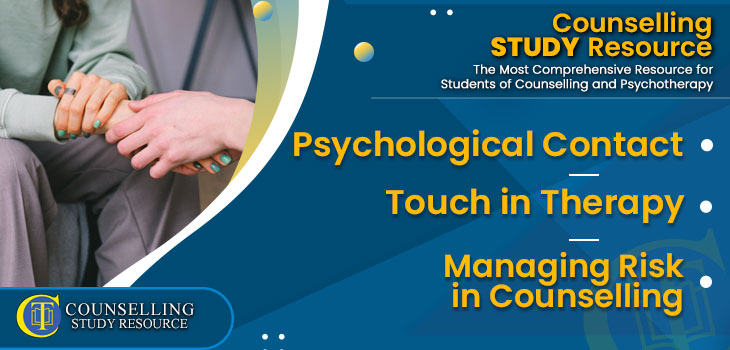258 – Touch in Therapy
Psychological Contact – Managing Risk in Counselling
In Episode 258 of the Counselling Tutor Podcast, your hosts Rory Lees-Oakes and Ken Kelly are back with this week’s three topics:
- Firstly in ‘Theory in Practice’, we look at psychological contact.
- Then in ‘Practice Today’, Rory and Ken share their thoughts on touch in therapy.
- And finally in ‘Practice Matters’, Rory speaks with Sally-Anne Armitage on managing risk.
Psychological Contact [starts at 02:30 mins]
Counselling Foundations is sponsored by
Counselling Skills Academy
Learn counselling techniques by seeing counselling skills used in real sessions by qualified therapists.
Real sessions - real-life presentations - real skills.
Psychological contact was recognised by Carl Rogers as an important condition of person-centered therapy. In this section, Rory and Ken discuss psychological contact, and the things that may stand in its way:
- It’s important that the client understands where they are and what they're there for – do they know what process they're going in for?
- The client needs to want to be there.
- A client understanding of what they are there for may be impaired by things such as Alzheimer's/dementia, medication, alcohol, or a language barrier.
- You may require cultural awareness when it comes to forming a psychological connection with your client – whether it be religious, class, sexuality or gender-related. Without this you could miss the client, it’s important to meet the client where they're at.
- The psychological contact can be broken at any point during the arc of therapy – a misstep may lead to the client switching off.
- If this happens, it will need to be built back up.
- Alternatively, if you feel you aren’t a fit for this client, a referral might be best.
A handout on Psychological Contact is available for download in the green button above.
Touch in Therapy [starts at 16:27 mins]
Touch in counselling is something that can differ from practitioner to practitioner. In this section, Rory and Ken share their own thoughts on touch in therapy, and some things you may want to consider:
- If you are working with children and young people – touch is not to be used under any circumstances (with exception to CPR etc.)
- When working with adult clients in therapy, it may be tempting to offer a gentle touch to the hand/arm, or even a hug to let the client know someone is there – any touch in the therapy room should be heavily thought about and considered.
- If you do choose to offer a reassuring touch to your client, this should be written in your notes and taken to supervision.
- If a client asks for a hug, informed consent has been given and this is completely fine.
- You may want to write physical touch into your counselling contract (either for or against), just to make the possibility clearer to the client, or allow them to share what they're comfortable with.
- Physical touch can sometimes pull the client from what they're feeling, and this may not always be beneficial for the process of the session.
- If you feel like you want to hug the client – think about why that is. Is it possible you are experiencing transference? Do you see yourself in the client?
- If the hug is more for yourself than the client, this is something you will want to take to supervision, and maybe consider looking at in some counselling of your own.
- No matter what, using touch in therapy should never be a spur of the moment impulse – it should be carefully contemplated and considered.
Managing Risk in Counselling [starts at 28:52 mins]
The National Counselling Society is proud to sponsor Practice Matters.
NCS are really excited to have launched their Children and Young People Therapist Register for counsellors working with the younger age group.
In this week’s ‘Practice Matters’, Rory speaks with a close friend of Counselling Tutor, Sally-Anne Armitage on managing risk.
The key points of this discussion include:
- When it comes to having concerns about a client, it’s okay to communicate this concern with a client – it can be important to have these difficult conversations, free of judgement.
- Talking about suicide doesn’t make it more likely.
- Be transparent about risk – this is the space to talk about it, make it known to the client that it’s okay to speak about.
- If suicide is something a client speaks about often – make sure you're still checking in from time to time, assess whether the situation has worsened.
- People who self-harm are not always suicidal.
- Ask the client if they have a plan – this allows you to assess intention and the urgency/height of the risk.
- If the client has made previous attempts to take their own life, they sit at higher risk.
- The risk for children and young people is generally higher.
- When working with children and young people, you will need to think extra carefully about disclosure and confidentiality – and when this may need to be broken.


